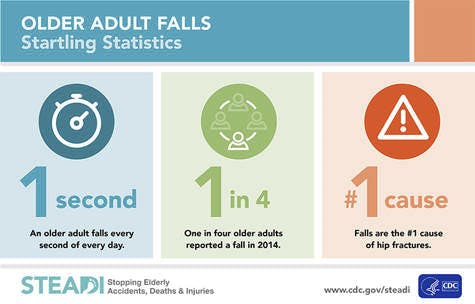More than 30% of people 65 and older fall each year. This increases to 50% for those in their 80’s. Two-thirds of those who fall will fall again within 6 months. Those who fall are more likely to move into a nursing home. Worse, falls are the leading cause of injury, death, and hospital admissions for traumatic injuries in people 65 and older.
Falls and problems with balance will not resolve on their own. If you are feeling unsteady or have already had a fall, the time is now to do something about it. Start the best balance exercise program.

The Answer: A Balance Exercise Program Proven to Reduce Falls
Researchers from New Zealand developed the Otago home exercise program to reduce falls in older adults. This fall prevention program improves strength and balance. More importantly, it reduces falls and fall-related injuries among older adults. Completing the exercise program has proven to reduce falls by an astounding 46%!
Results have been even better in adults over the age of 80. Besides these exercises being beneficial for reducing fall risk, most participants find them enjoyable. 70% continued exercising after one year. Any effective exercise program must be maintained to sustain any benefits.
Balance Exercises within Your Own Home
The Otago exercise program includes strengthening, balance exercises, and a walking program. It should be done 3 times per week. The strengthening and balance exercises take about 30 minutes total to complete. These can be done at once or spread over the day.
The walking program includes 30 minutes of walking at least twice per week. If needed, the walk can be broken up into 2 or 3 smaller walks. For example, instead of walking continuously for 30 minutes, you could spread 3 10-minute walks out over your day.
The program is very flexible but is designed to become more challenging as your strength and balance improve. The following 5 videos show examples of some exercises included in the program.
The Role of Your Physical Therapist
Your exercise program is prescribed after your physical therapist assesses your balance. This includes an evaluation of your walking, ability to stand from a chair, and a four-stage balance assessment. You must start with the most appropriate exercises. Beginning with exercises that are too easy for you will result in little improvement. Also, beginning with exercises that are too challenging may be dangerous.
After your initial assessment, you are given instructions for your home exercise program. You will follow up with your physical therapist every few weeks to assess your progress and advance your exercises. Your physical therapist guides you in the right direction. However, results depend on your ability to remain consistent with the program. No one can do the exercises for you!
Get Started with Your Balance Exercise Program
The doctors of physical therapy at BSR have extensive experience working with older adults who have fallen. Many have benefited greatly.
Still, some people attempt to justify or make excuses for their fall. Some say, “The curb was too high.” Other people say, “The wet floor caused my fall.” Denial of your balance problem only magnifies the danger. A fall is a fall. Once you have experienced one, no matter the cause, your risk for another rises exponentially.
Take charge of your balance, your health, and your freedom. Start an exercise program that is right for you. Give us a call and your physical therapist will help you begin and stay on track.


